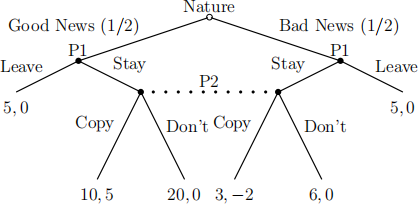ECON 7710 Micro Theory II
Hello, dear friend, you can consult us at any time if you have any questions, add WeChat: daixieit
Sample Final Exam
ECON 7710 Micro Theory II
1. Suppose the indirect utility function is
v(p1,p2,w) = ln w − alnp1 − blnp2 .
(a) What are the Marshallian demand functions x1 (p1,p2,w) and x2 (p1,p2,w)? (b) What is the expenditure function?
(c) What are the Hicksian demands, h1 (p1,p2,u) and h2(p1,p2,u)?
2. Suppose that a production function is given by y3 = ln(y1y2), where y1,y2 denote the quantity of the inputs and y3 denotes the output.
(a) If prices are p = (p1,p2,p3), solve for the profit-maximizing value of y = (y1,y2,y3).
(b) Compute π(p), and use this function to confirm Hotelling’s lemma.
3. Suppose a consumer has an expected utility function of the form u(w) = √w and an initial wealth of $100.
(a) Is the consumer risk averse, risk neutral, or risk seeking? Explain. (b) What is the Arrow-Pratt measure of absolute risk aversion?
(c) Define the certainty equivalent of the lottery, and, for this utility function, find the certainty equivalent of an additional $300 with probability 1![]() 2 .
2 .
4. (a) What is the definition of a homothetic utility function? (b) Is u(x,y) = xαy1 −α homothetic?
(c) What is an implication of the homothetic function property for the shape of indifference curves?
![]()
![]()
![]()
![]()
5. Consider a simple two-period repeated prisoner’s dilemma. The one-shot game is

(a) What is the Nash equilibrium of the one-shot game?
(b) What are each players’ complete strategy sets in the two-period game?
(c) What is the subgame perfect equilibrium of the two-period game?
(d) If there are other Nash equilibria of the two-period game, describe one. If not, explain why not.
6. Consider the following extensive form game:

The players are choosing whether or not to stay or invest in the current location or move on and look for a new location. Nature moves first and Player 1 (information sets labeled P1) gets either good news or bad news about whether to stay at the current location, or move on and look for a new location. The information could be bout whether or not to drill for oil, whether or not to open a business, or whether or not to start farming.
Player 2 is an imitator. He or she has no information, but can copy the decision of the informed player.
For simplicity, we will assume that Player 2 never stays if Player 1 leaves. Also, note that the payoffs imply that Player 1 has a better outside option than Player 2, possibly because Player 1 expects to be able to gather new information in the future if he or she moves on.
As we have done in the past, assume both players are risk neutral (or equiva- lently that the payoffs are in utility and they maximize expected utility).
(a) Does this game have a pooling perfect Bayesian equilibrium? Explain. (b) Does this game have a separating perfect Bayesian equilibrium? Explain.
(c) Show the normal form or strategic-form version of this game including the expected payoffs. What are the Nash equilibria of the game (find both pure and mixed strategy equilibrium)? Explain. Even, if you don’t solve this completely, give as much explanation as possible.
(d) Are the perfect Bayesian equilibria and the Bayesian equilbria of this game the same or different. Explain.
7. Suppose, as wed did in class, that the utility function of a worker is

where w is the wage and e ∈ {0,.5} is the level of effort. Suppose the reservation utility is 1.
Furthermore, suppose the outcome is $6 or $2 and that the probability of the $6 outcome is .5 if the worker works hard and the probability is 0 if the worker chooses low effort.
(a) If you could costlessly monitor the worker’s effort, would you choose to have the worker work hard? What payments would you offer and for what effort?
(b) Suppose you cannot monitor (or alternatively cannot contract on) the worker’s effort, but you can contract on the outcome. Subject to the constraints that the worker is wiling to sign the contract, and the worker seeing the contract will choose to work hard, what contract will you offer?
(c) If instead you want the worker to extort low effort, what contract will you offer?
(d) Which contract is more profitable, the one that induces high effort or low effort?
(e) Suppose instead of the monopsony assumption implicitly made above, several firms competed for a single worker under the same conditions. Intuitively, how would you expect this to change the above contracts?
8. In the theory of monopolistic screening, such as the price discrimination ex- ample discussed in class or the task assignment model discussed in Mas-Collel, an uninformed player offers contracts to one or more informed players and can contract on price as well as some other dimension (quality or tasks) that we call a ’screen’ because it helps the uninformed player separate the informed players and sign different contracts with different ’types’. The theory has the feature that an equilibrium exists and that the contract written with the ’best’ type is not distorted (that is, the screen is equal to the screen chosen under complete information).
(a) A screen only increases the uninformed players profits under some con- ditions or assumptions. What is the assumption that we made in the price discrimination (or task assignment) model that implied the screen would increase profits (relative to offering all of informed types the same contract).
(b) Intuitively, why is the existence of an equilibrium with hidden information (or adverse selection) a problem when there are competitive uninformed players, but not when there is just one uninformed player?
2021-12-11